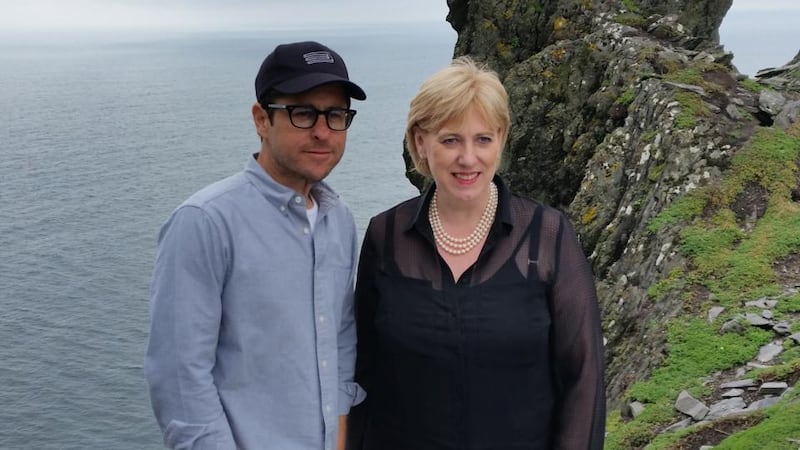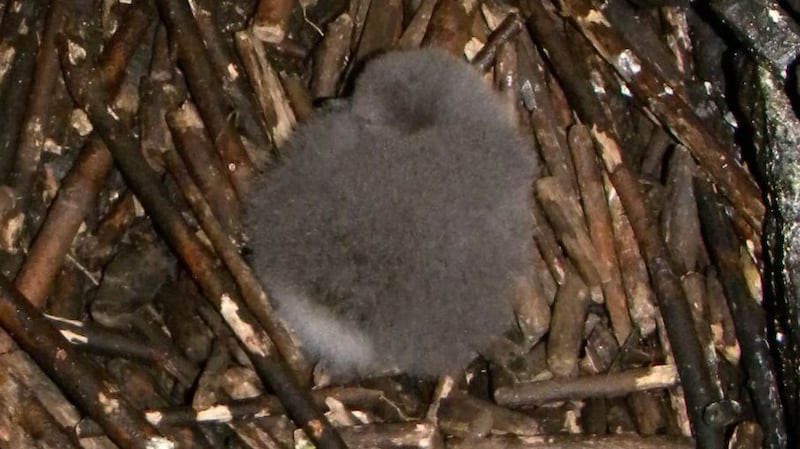A guide who has worked on Skellig Michael, off the Co Kerry coast, for almost three decades says that her experiences over the past two years still cause her to feel deeply concerned about the Government's decision to allow scenes for Star Wars to be filmed on the Unesco Skellig Michael UNESCO World Heritage site.
Claire O'Halloran, who has been an Office of Public Works guide on Skellig Michael for 28 years, claims that Minister for Heritage Heather Humphreys gave filming the go-ahead on the basis of incomplete ecological data. She also claims that conditions were breached, that reported damage was downplayed and that "control failures" went unreported.
O’Halloran, who is able to speak independently because she is off contract at the moment, says that “some necessary protections no longer seem secure”; she is also concerned about the potential for more filming.


One of the Star Wars producers, Kathleen Kennedy, who is also president of Lucasfilm, the Disney-owned production company that makes the series, has indicated that the film-makers want to return to Skellig Michael, where scenes for the JJ Abrams-directed Star Wars: The Force Awakens were shot in 2014 and where scenes for the eighth instalment, directed by Rian Johnson, were shot last year.
The Force Awakens, which was released in December, has already earned $2 billion at the box office. Tourism Ireland and Fáilte Ireland have launched advertising campaigns, both nationally and internationally, on the back of the film's release.
International reputation
O'Halloran's employer, the OPW, manages Skellig Michael and oversees seasonal tourist visits to the island. With its 670 steps leading up to its sixth-century monastery, 230m or so above sea level, the World Heritage site is a national monument with an international reputation for its archaeology; it is also part of a special protection area for its colonies of puffins, Manx shearwaters and storm petrels. That status prompted Birdwatch Ireland and experts in heritage and archaeology to criticise the initial decision to permit filming there in 2014.
O'Halloran expresses concern about the "pressure" on the OPW to facilitate the filming and says that a "destructively large-scale plan" for the 2014 shoot was averted only at the last minute, after the intervention of the National Parks and Wildlife Service. She adds that the film board, which promoted the location, appeared to be "completely unaware" of the sensitivity of Skellig Michael, which is one of the statutory nature reserves that the wildlife service monitors; the island is also covered by EU birds and habitats directives.
Under the Freedom of Information Act The Irish Times has obtained a large volume of correspondence between the Irish Film Board and various parties involved in the shoot. It shows that the wildlife service was not formally consulted about the first shoot, in late July of 2014 – the middle of the seabird breeding season – until early that month. Filming had originally been planned for September but was brought forward to facilitate Lucasfilm.
Naoise Barry of the Irish Film Board had been involved in pitching Ireland as a location from early 2013, according to the correspondence. He first contacted the OPW about Star Wars in January 2014. The OPW says the film board's first formal engagement regarding the project was on February 14th that year.
Barry then co-ordinated contact between the film-makers, the OPW and the Department of Arts, Heritage and the Gaeltacht, assuring the film-makers of a “high level of OPW support and co-operation” but not mentioning the need to include the wildlife service or consult Unesco.
It was only when the film-makers planned to import grasses and ferns, to dress the set, a month before filming, that the OPW flagged the implications for Skellig Michael as a nature reserve. Barry offered to the film-makers that he would “step in” if “significant problems” were encountered with the National Parks and Wildlife Service.
Scaled down
The wildlife service then sought an environmental assessment. In an email on July 11th, 2014, the first film’s supervising location manager outlined the scaling-down of the project to “bare essentials”, cutting a team of 300 to 60, restricting helicopter traffic to 14 passenger flights, and scrapping plans to drop equipment to Skellig Michael by air.
When Frank Shalvey, who oversees national monuments at the OPW, emailed Barry over reservations about the location contract, several days before the first delivery of equipment, he alluded to Barry’s “strong response”. At this point the Attorney General is reported to have warned of possible legal issues, because of the island’s protected status under the EU directives. During one reconnaissance helicopter flight for the first shoot, kittiwake chicks were swept into the sea by the downdraught and eaten by gulls.
In a subsequent report for Unesco, the Department of Arts, Heritage and the Gaeltacht played down the role of the Irish Film Board, saying that the Star Wars location-management and production team had been referred to the wildlife service and the National Monuments Service, which is responsible for the archaeological management of national monuments in State care.
The department also said that the film company had submitted a “detailed method statement” with a number of mitigatory measures. It did not make clear that the ecological assessment and consultation with the NPWS were all within less than a month of the shoot.
Against this backdrop, the department tried to be much more cautious when Lucasfilm planned its return last year, this time in September.
Consent was again sought from Heather Humphreys, who is responsible for the Irish Film Board and for the National Monuments Service and the National Parks and Wildlife Service. This time her agreement was informed by an assessment and screening report prepared by Malachy Walsh and Partners, an engineering consultancy.
The wildlife service was asked to assess this report; it noted that there was a fundamental difference with this second Star Wars application, as several of the breeding seabird species of the Skelligs would have "left the island, or completed their breeding cycle by September".
Claire O’Halloran says that storm petrels and Manx shearwaters were still nesting in September; she adds that the assessment report would not have had time to confirm this, as the consultancy was asked to conduct surveys from June to August 2015.
According to that report, the storm petrels' habitat would "not be affected by the film shoot". O'Halloran says that Humphreys was therefore asked to approve Star Wars' return to Skellig Michael on the basis of incomplete ecological data.
The wildlife service recommended that Humphreys allow the second round of filming on 16 conditions, to protect “any remaining seabird species still engaged in breeding activity” and to ensure “stringent biosecurity”. It also recommended that a supervising ecologist be present during filming, along with agency staff, who could “stop or modify any filming or other activity”.
In its subsequent report to Unesco the department confirmed that no archaeological consent was given under the National Monuments Acts 1930-2004, as “no works were contemplated or carried out that would have come within the scope of the consent framework”.
Yet one of two incidents during last September’s shoot, which were recorded in the report for Unesco, involved the island’s archaeology. The incidents were classified as minor, but according to Claire O’Halloran they were actually significant.
One was recorded as “disturbance” to stonework at the entrance to the upper monks’ garden; the other was a paint spill at a rock formation known as the Wailing Woman. Humphreys said afterwards that both were dealt with immediately and would “have no long-term impact whatsoever and no ecological consequence”.
A report compiled for her noted that the damage “mirrored a similar occurrence” in mid-June, when a visitor dislodged the same section of stone, possibly by knocking against it with a rucksack. “The reality is that the filming posed no greater challenge to the island than the 180 people who visit it every day during tourist season,” the Minister said.
O’Halloran says that the damage to the monastery entrance was so bad that people were stopped from using it until it was propped up. The damage extended through the arch to the outer wall, with upper courses of stone and two lintels left sagging, until a more comprehensive repair was carried out on October 1st, she says.
O’Halloran adds that four of the 16 conditions set by Humphreys’s consent were breached, to do with time limits on filming, use of specified areas, and use of helicopters. A report O’Halloran has prepared is before the OPW.
She says that she witnessed "many unreported control failures", reflecting the "overwhelming scale of the project", during the set-up and in the days immediately after the shoot. She was on duty for six of Star Wars' 12 days on Skellig Michael.
“I have my own records of young birds of both species still in nests underfoot, some of them located where these activities were at their heaviest,” O’Halloran says. “The smallest of these birds, the storm petrels, nest in large numbers in the old monastic steps”; that fact, she explains, is part of the reason why visiting hours and tourist numbers are restricted. “During the filming the steps were under very intense traffic, with people carrying heavy loads for 12 hours a day.”
She says that it was disturbing to see how much repair work was needed. “The whole island is suffering greatly from heavier rains, heatwaves; there is an increase in erosion and rockfalls and dieback of vegetation on the slopes from winter and summer storms. There were two seasons when the puffin and other seabird breeding failed because warmer seas destroyed food supplies,” O’Halloran says. “So anyone who knows or cares for the island should be asking if this is the right time to be adding other challenges and endangerments to what is here and what is so uniquely our own.”
“Completely open”
O’Halloran says that she has been completely open with the OPW about her concerns and that the agency has accepted all of her correspondence.
“I am mainly requesting that everything which has occurred would be more closely examined, as I believe that it has involved failures of adequate protection which could and should be avoided in future,” she says.
“I do also believe that some of the great sensitivities are not always well understood, particularly by the public at large, and in this context we have a better job to do in order to prevent more violations.”
Birdwatch Ireland is pursuing what it describes as the use of a legal loophole in the consent procedure for last year’s shoot. It says that Humphreys was in breach of the EU habitats directive – a charge the Minister has denied, saying that all legal procedures were followed and that the European Commission “took no issue with how the matter was handled”. Her department has described O’Halloran’s claims as without foundation.
“The department and its experts remain completely satisfied that the impacts suggested . . . do not stand up to scrutiny and, furthermore, notes the significant positive attention which has been brought to this most important Unesco site as a result of the filming project,” it said in a statement.
The Irish Film Board said it was “always aware that Skellig Michael is a Unesco World Heritage site and has always been respectful of this designation in all of its dealings”.
The OPW confirmed in response to queries that it was not paid a location fee for use of Skellig Michael by Disney Lucasfilm in 2014 and 2015. A fee had been alluded to in early correspondence from the Irish Film Board.
The OPW said it was not aware of any plans for the company to return. On the issue of O'Halloran’s report, it said it did not generally comment on any “internal engagement” with its own staff.
Malachy Walsh and Consultants and Disney Lucasfilm declined to comment for this article.

















